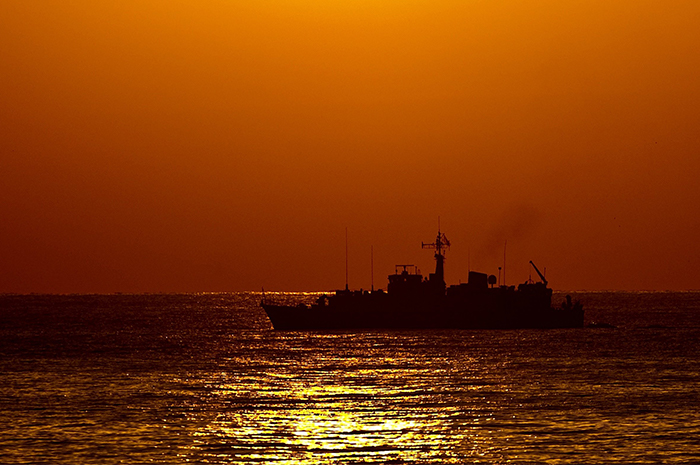The UK’s ORCA mine countermeasures CMS programme
How a combination of open architecture and innovation is delivering significant upgrades to the Royal Navy’s Hunt and Sandown Class minehunters.
Mines are a global threat. Their increasingly hi-tech nature and affordability – compounded with more cluttered maritime environments – have resulted in a lethal cocktail in today’s ‘asymmetric times’ that can be deployed by both terrorists and rogue states. Mine countermeasures are rapidly moving centre-stage and teams can now be called upon to operate anywhere in the world, at the drop of a hat, from protecting aircraft carriers to clearing critical water space.
Against this backdrop, as the mine warfare command and control systems on the Royal Navy’s Sandown and Hunt Class Mine Counter-Measures Vessels (MCMVs) need upgrading, the UK’s MOD is determined to introduce a new system solution which will better address the changing threat environment.
The Royal Navy needs to continually update its mine warfare command and control systems to ensure its ships and people are fully able to deal with the changing threat environment.
The UK’s vision goes well beyond ‘keeping up’. It seeks to ensure the MCMVs are kept at the cutting edge of conventional mine countermeasures into the 2030s – by switching to state-of-the-art ‘plug-and-play’ open architecture, supported through life and integrated with other sensor suites.
The MOD is clear on the need to hugely enhance data processing and presentation capabilities – driving much greater clarity on congested underwater environments; reducing ambiguity and cutting the need for subjective judgements; and better informing command decisions.
In 2018, it distilled this careful thinking into its ORCA (Oceanographic Reconnaissance and Combat Architecture) Programme – putting it out to competitive tender. Its M-Cube solution was both technically advanced and an excellent fit to the spec. It was based on the core infrastructure of Thales’s proven TACTICOS family of command and control systems, which have been widely deployed in other applications and also form the core infrastructure on the Anglo-French Maritime Mine Countermeasures (MMCM) and Type 31 Multi-Purpose Frigate programmes.
The M-Cube solution offered a raft of innovations: advanced planning tools, real-time mission efficiency calculations and a powerful database to marshal chart, route, seabed, and environmental information. Its multi-view HMI weaves together a host of signals, pre-populating screens with dozens of data inputs once done manually. It can automatically optimise other ship functions too – such as fine-tuning sensors to the operating environment. What’s more, the component-based, open architecture means third-party apps can be inserted rapidly, and developed for specific missions or new autonomous systems.
As well as giving an excellent match to the customer’s requirements, M-Cube delivers in terms of through-life affordability and rapid deployment from experience gained at sea with five other navies.
But the icing on the cake was the effort put in by Thales’s experts to communicate how M-Cube could be tailored to the Royal Navy’s exact needs under ORCA. In early 2019, Thales was selected to upgrade the systems on seven Sandown Class and six Hunt Class MCMVs – as well as providing training, a pioneering land-based test site for future technologies and algorithms, and in-service support.
As things moved forward rapidly on the first ship in class, HMS Pembroke, Thales was determined not to let a Covid-altered world delay the programme or testing. It worked seamlessly with the Royal Navy and MOD on detailed procedures to ensure Thales team members, their colleagues and families were kept as safe as possible.
ORCA’s increased mine warfare command-and-control capability is being further complemented by the Royal Navy’s concurrent introduction of the Sonar 2093 Capability Sustainment Programme. This will deliver a step change in underwater battle space visualisation, through its use of wideband sensor operating frequencies. The combination of ORCA and wideband Sonar 2093 will significantly enhance the Navy’s minehunting capability by ensuring higher levels of mine detection at greater stand-off distances.
HMS Pembroke has now been approved for operational use and has re-joined the Royal Navy’s fleet of vessels carrying out vital MCM operations. The verdict on the first in class for ORCA? Very positive: a significant improvement in the Royal Navy’s minehunting CMS performance; additional synergies from its alignment with other Thales C2 systems at sea with the navy; and a step change in operator assistance. This modern capability will give Hunt and Sandown ships a real edge as well as options for future maritime autonomy. Thales’s focus now is squarely on delivering ORCA for the next ships in the series – on time and on budget.



